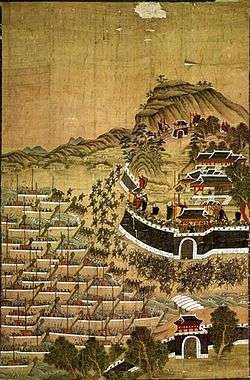Nose tomb

Japanese invasion of Korea in 1592
Nose tombs (鼻の墓) are tombs that contain human noses or other body parts that were brought back to Japan as trophies during the Japanese invasions of Korea in the late 16th century.[1] War trophies were a part of Japanese tradition at the time and samurai warriors were often paid according to how many they collected.
One such nose tomb was discovered in 1983 in Okayama near Osaka. This tomb held the severed and pickled noses of approximately 20,000 dead Koreans which were eventually returned to Korea in 1992 and cremated.[2] A similar tomb still exists today in Kyoto called the Mimizuka, literally "Ear Mound".[3]
In Japan, these tombs are considered relics by the few who are aware of them, but in Korea these tombs are very well known.[4][5]
See also
References
- ↑ Diamond, Jared (2004-10-27). "The Japanese Roots (Part 1)". Association for Asia Research. Retrieved 2010-10-26.
- ↑ "20,000 Noses Of Koreans Being Returned By Japan". Orlando Sentinel. September 23, 1992. Retrieved 6 December 2015.
- ↑ Giants of Japan: The Lives of Japan's Most Influential Men and Women
- ↑ Kristof, Nicholas D. (September 14, 1997). "Japan, Korea and 1597: A Year That Lives in Infamy". The New York Times. New York. Retrieved 2010-05-28.
- ↑ Thorpe, Norman (1972-04-01). "Mimizuka: A Shrine to Japanese Brutality in Korea". Korea Journal. 12 (4): 58–59. Retrieved 2010-05-28.
This article is issued from Wikipedia - version of the 10/5/2016. The text is available under the Creative Commons Attribution/Share Alike but additional terms may apply for the media files.